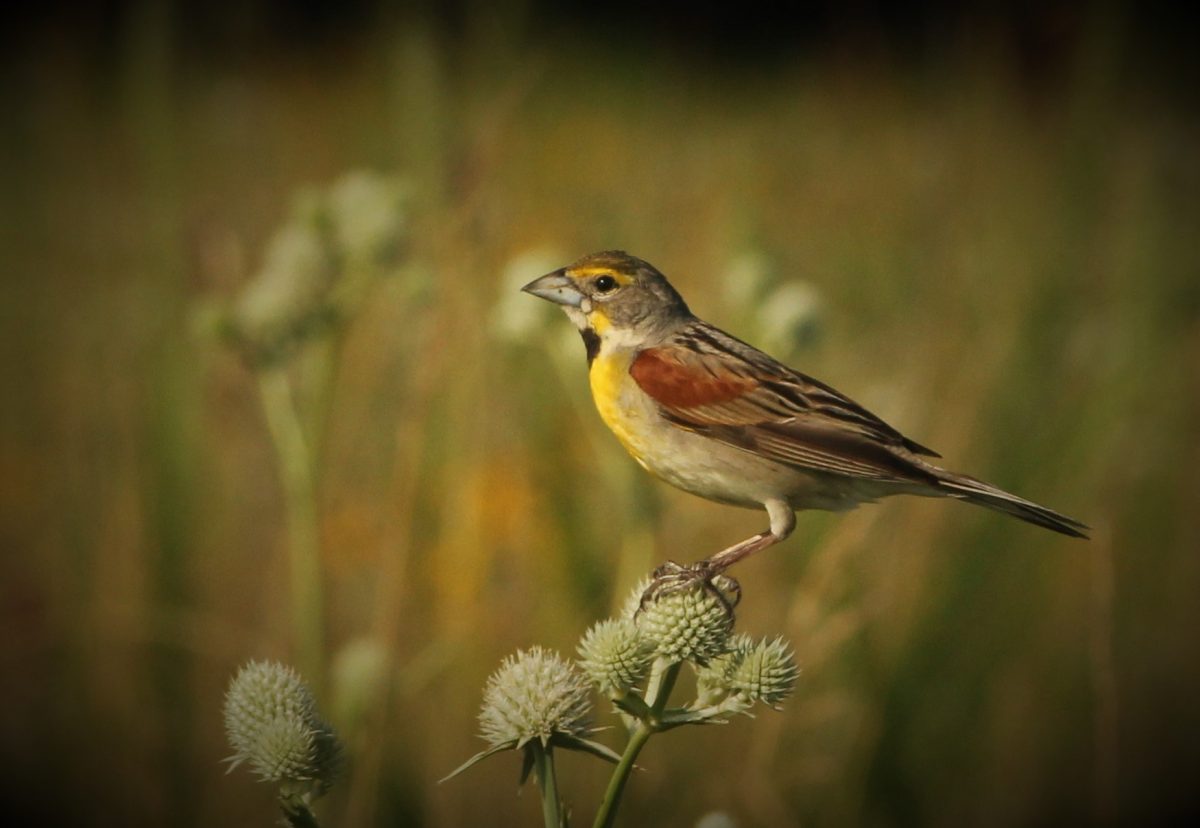Known for their subdued beauty, prairies and other native grasslands are much more complex and invaluable than their subtlety suggests — surpassed only by the rainforest of Brazil in their biodiversity.
They provide critical habitat for pollinators and many other wildlife species — and contain the largest representation of threatened and endangered species of any type of natural area; protect soil from erosion; cycle and move nutrients; help ensure clean water; and even help mitigate climate change by storing carbon. (In fact, one study done in California found that grasslands are more reliable carbon sinks than trees.)
Native grasslands are essential to plant, animal and human health.
However, much like the bison they used to sustain, they too are rapidly approaching extinction, many experts warn.
That prairies have also attracted the attention of developers, farmers and oil and gas executives is not surprising. While these land uses are sometimes necessary, what has many concerned is the toll they have taken on the landscape.
The dramatic loss of prairie and other native grasslands is a problem that Carol Davit, executive director of the nonprofit conservation organization and land trust Missouri Prairie Foundation, says continues to this day.
“In terms of Missouri, there were 15 million acres of prairie at the time of statehood, and now we have fewer than 60,000 scattered, original, unplowed acres, so that’s less than one half of 1 percent.”
“Most prairie in Missouri was converted as recently as 200 years ago, but conversion continues today for agricultural purposes and for other kinds of human development — roads, subdivisions, shopping centers, what have you. While we tend to think of that happening hundreds of years ago, it continues to happen,” says Davit. “I know of an original prairie that was plowed under for crops this summer.”
Today, fewer than 40 percent of what was once 550 million acres of North American grasslands remain, according to the National Audubon Society’s 2019 National North American Grasslands and Birds Report. Furthermore, by some accounts, grassland cover in certain areas — particularly in wetter, more fertile eastern tallgrass prairies — has declined by more than 99 percent since 1830.
“The figures really speak for themselves,” says Davit. “In terms of Missouri, there were 15 million acres of prairie at the time of statehood, and now we have fewer than 60,000 scattered, original, unplowed acres, so that’s less than one half of 1 percent. That’s an incredible decline, and prairies are very much imperiled, so we feel it’s important to protect as many of those remaining acres as possible.”
The Missouri Prairie Foundation’s mission is to protect and restore original prairie and other native grasslands, which Davit says it does by acquiring land — when it has the funds to do so — and assertively managing those acres to perpetuate their native biodiversity. The organization now owns 22 parcels comprising 3,300 acres largely in southwestern Missouri, all of which are open to the general public for hiking and nature viewing.
“Each one of those remnant prairies — be they 40, 100 or 500 acres — are critically important,” Davit says. “They remain vital habitat for many species that can grow nowhere else on Earth, and they provide important habitat for many grassland birds and other animals. They are also reservoirs for pollinators.”
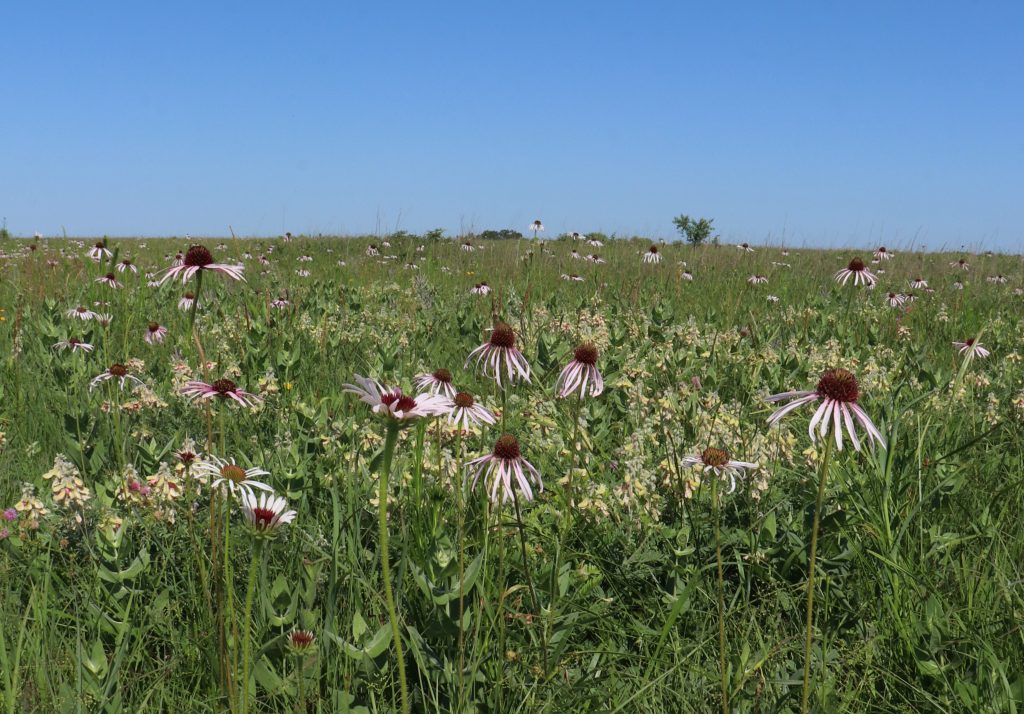
One of the first actions Davit and her three-person staff take when they acquire new property is to collect baseline information about the types of flora and fauna that are present there. Because grasslands are threatened, so too are many of the species that depend on them for survival.
“We do very in-depth botanical surveys, we do bird surveys, we do pollinator surveys,” she says. “Prairie is extremely rare, and we manage for all species on those prairies, with particular attention paid to those that are prairie obligates.” This refers to those that can survive nowhere else but on prairie — specifically, original, unplowed prairie. Some examples include the grass pink orchid, northern crawfish frog, ornate box turtle, regal fritillary butterfly and other prairie-specific insects.
Yet even species capable of surviving elsewhere still rely on native grasslands.
“There are prairie-obligate animals and then there are grassland animals, including a lot of birds like northern bobwhite and meadowlarks,” says Davit. “Those are not specific to original, unplowed prairie — they can live in a number of different native grassland types — but they certainly use prairie, and we are concerned about them.”
Restoring and Maintaining Prairie
The fact that native grasslands tend not to garner as much care and consideration as other types of natural areas comes down to their lack of a singular, defining feature, says John Hart Asher, senior environmental designer with the Lady Bird Johnson Wildflower Center.
“Grasslands haven’t really received the widespread protection that you’ve seen [for] big forests or other natural areas. There’s usually a singular grand thing, like a sequoia or a waterfall … that people can latch onto.”
“Grasslands haven’t really received the widespread protection that you’ve seen [for] big forests or other natural areas,” says Asher. “There’s usually a singular grand thing, like a sequoia or a waterfall, El Capitan or some really significant feature that people can latch onto.”
Because of this, he says, native grasslands are one of the most — if not the most — threatened of all ecotypes in the world. “Grasslands covered 30 to 40 percent of the Earth in terms of ecotype, and those are all down below 1 percent of existing,” Asher says.
One of the ways the Wildflower Center has worked to change the conversation around prairies is to use wildflowers as “sort of that token thing of grasslands that people can appreciate and lock onto,” says Asher. Yet over the years, the center’s mission has expanded to include a focus on researching and advocating for not just wildflowers but all native plants.
Asher’s unit, the Department of Ecological Research and Design — which he calls “the center outside of the walls of the center” — works with communities to reintegrate native plants and prairies into the landscape.
Working with architects, landscape architects, engineers and other experts, he and his team consult with organizations, developers, cities and municipalities to restore original or create new prairie. These are designed for not just their aesthetic appeal but to also provide ecological function, says Asher. “That’s carbon sequestration, cleansing of water, cleaning air, heat island mitigation, that sort of thing,” he says. “We work on projects all over Texas, Oklahoma, Georgia — all over the nation — helping people understand how they can really restore their landscape.”
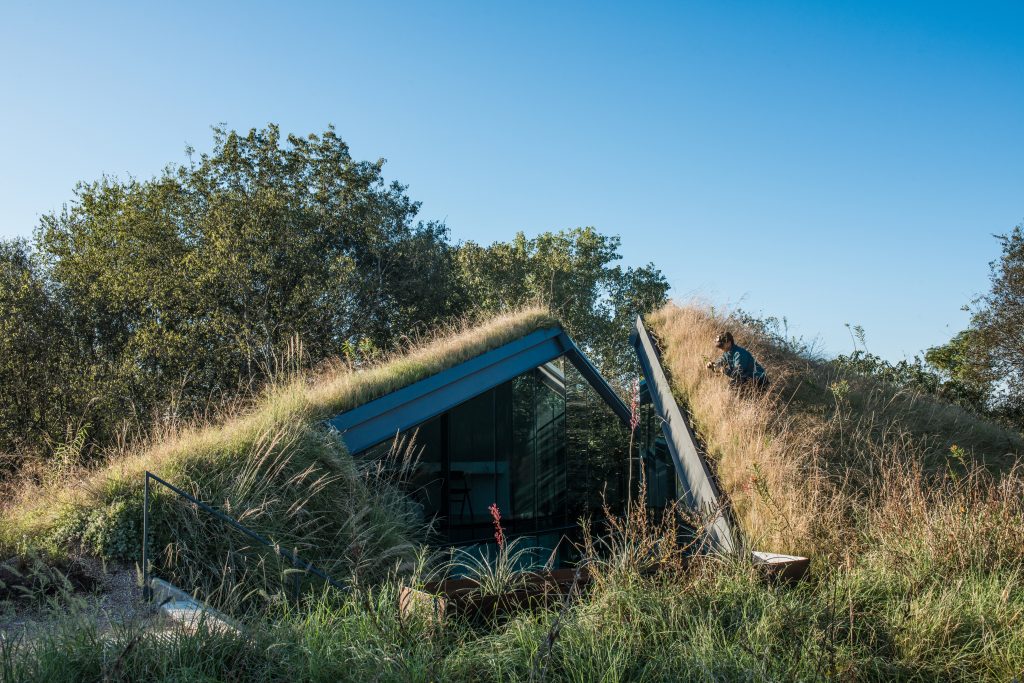
This work has included installing residential green roofs — like a recent project in Frisco, Texas, where they installed blackland prairie on the roofs of more than 100 homes — and incorporating native plants into landscaping in urban areas. One large-scale project by the Wildflower Center involved the restoration of eight miles of prairie along the San Antonio River.
But their work doesn’t stop once the project is complete. Asher and his team work with city or private staff to pass on their knowledge and train them on how to maintain these natural areas.
“These aren’t interventions. You’re starting something, and then this landscape is going to evolve over time, and you have to be able to monitor and adjust with that,” he says. “We can tell you every species you can put in there, we can seed it out, we can get it all ready, but if we don’t have somebody doing the proper maintenance and caretaking, then all of that initial effort is for naught.”
According to Asher, a lack of proper maintenance is, in fact, one of the greatest threats to native grasslands. These “disturbance-driven ecosystems,” as he calls them, require disruptions such as fire and managed grazing to limit tree growth and invasive species.
Such practices, Davit says, are critical for ensuring the diversity of flora and fauna. “With prairie, you can’t simply purchase it and set it aside,” she says. “It evolves with disturbances like fire, so it requires constant management to maintain its high level of inherent biodiversity.”
Changes in the way that grasslands are managed have contributed to the reduction of such disturbances as ranchers and farmers no longer rely as they once did on these landscapes for nutrition for livestock. Like the swing of the pendulum, farmers who once overgrazed suddenly rarely did, says Asher.
“[Prairie] evolves with disturbances like fire, so it requires constant management to maintain its high level of inherent biodiversity.”
In places where these disruptions were ceased, issues have often arisen.
“By removing fire, by removing grazers, you have this fuel buildup over decades. … It’s not a matter of if [those acres are] going to burn — it’s [a question of] when they’re going to burn,” says Asher, adding that if kindling is allowed to build up and a drought occurs, wildfires can have damaging effects. “They have so much fuel, those fires are inherently destroying the ecosystem because they burn so hot and so long; it essentially sterilizes the soil and eliminates your seedbank.”
Native Plants
Seeds are an important part of the Missouri Prairie Foundation’s focus as it seeks to promote the use of native plants in developed landscapes through its Grow Native! program. Previously managed by Missouri state agencies since 2000, the Missouri Department of Conservation selected the Missouri Prairie Foundation to take the reins of the program in 2012.
“The goals are to increase the supply of and the demand for plants that are native to the Lower Midwest — which includes Missouri, southwest Illinois, northern Arkansas and eastern Kansas — for their many benefits to wildlife, pollinators and people,” says Davit.
Both a consumer education program and a professional network, Grow Native! provides resources to help gardeners, farmers, city planners, native plant professionals and others use native plants in altered landscapes. Its online Native Plant Database makes it easy to find the right plant for your region, space and needs; plants can be filtered by characteristics such as season, wildlife, sun, soil and a number of other factors. The site also features a number of “top 10” lists focused on specific functions or conditions, such as the best native plants for attracting bees or the best native plants for a shade garden.
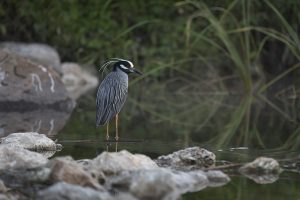
Grow Native! currently has more than 150 professional members, who Davit says include native seed producers, landscape designers and architects, educators, retail garden centers, native plant nurseries and others. “We also invite Grow Native! professional members who sell plants and seeds to native plant sales that we organize and host all around the state,” she says.
A resource such as Grow Native! — which Davit says is seeing great success in increasing demand for native plants — demonstrates the importance of native grasslands for not just the species they sustain but also the seeds they produce. This is especially important when it comes to prairie restoration as well as incorporating native prairie plants into urban environments.
“While we may be living hundreds of miles from a remnant prairie somewhere else in Missouri, if we care about using native plants to improve stormwater in, say, St. Louis, or we want to improve habitat for pollinators in our backyards,” says Davit, “we have a direct connection to those remnants because they are the sources of seeds from which we can propagate more plants to go to work for us.”
In fact, a large part of Grow Native!’s focus has been to promote native species in more populated areas, among homeowners, business owners and governmental agencies.
“Why should we need to travel hours outside of our towns to [see] a healthy landscape?”
“If you want to increase demand, that means we need to market natives to consumers — like you, like me, like homeowners everywhere, like cities, like schools, anybody who might buy plants,” Davit says.
Promoting and advocating for native plants also means combating invasive ones. In 2019, the Missouri Invasive Plant Task Force, as part of the Missouri Prairie Foundation’s Grow Native! program, unveiled a ranked assessment of 142 invasive plant species in the state. The comprehensive list ranks known invasive plants according to their impact, spread and abundance. It’s designed to help landowning and land-managing groups in the state “get a handle on the challenge of invasive plant species and use it as a planning tool to prioritize invasive plant management,” says Davit.
In addition, Grow Native! created a pledge that any private or public entity or individual can take, which signifies their commitment to managing their property for invasive species. According to Davit, more than 90 organizations or individuals have taken the pledge since it was launched last year. Pledge takers include farmers, the University of Missouri-Columbia campus, at least two cities and others.
Increasingly, Asher says his own projects are more urban than rural. “Cities have seen the research and understand that we have to get that biodiversity back into [urban areas],” he says. “So, now, we are often contacted by municipalities and cities for different efforts in which they are doing these large-scale restoration projects — because why should we need to travel hours outside of our towns to [see] a healthy landscape?”
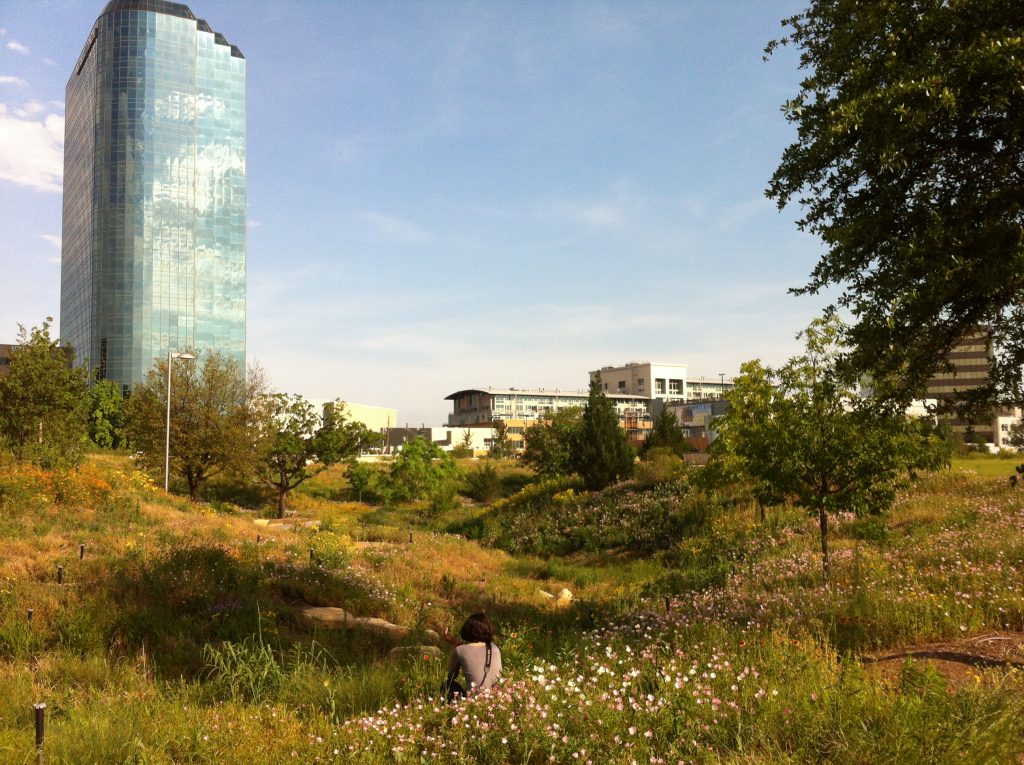
Incorporating Prairies in Your Yard
There is a lot that homeowners can do in their own yards as well to promote native grasslands and native species.
It’s important to consider factors such as how much sun your yard gets, your soil type, what invasive species are in your yard, space requirements, how much time you have or are willing to commit and what species are native to your area. On his own projects, Asher adheres to a 250-mile radius when it comes to finding native seed.
While he advises people to do their homework on what is appropriate for their region, he notes that you are usually limited to what is available from local nurseries and seed sellers. “You really want to try to source stuff as close to you as possible,” Asher says.
Among those who prefer more formal, conventional yards, he says it can be a struggle to change minds. When it comes to native prairie plants, some people simply don’t like their weedy or unkempt appearance.
“It’s really about separating from that and creating order from perceived chaos,” says Asher. “Now, we’re [going] in the other direction, understanding that that chaos is actually diversity, and there are a lot of pluses that come out of that.”
The Missouri Prairie Foundation’s Grow Native! program offers resources to help native newbies, with designs that feature plants that are suitable for more conventional landscaping. “There’s certainly the matter of everybody has a different idea of what’s beautiful,” says Davit.
Grow Native! has created two garden designs called “front yard formal” — one for sun, one for shade — that feature plants well-suited for a more formal look, such as butterfly milkweed. “It has a compact structure, almost shrub like,” says Davit. “It has a tidy appearance whereas common milkweed is sort of less formal looking.”
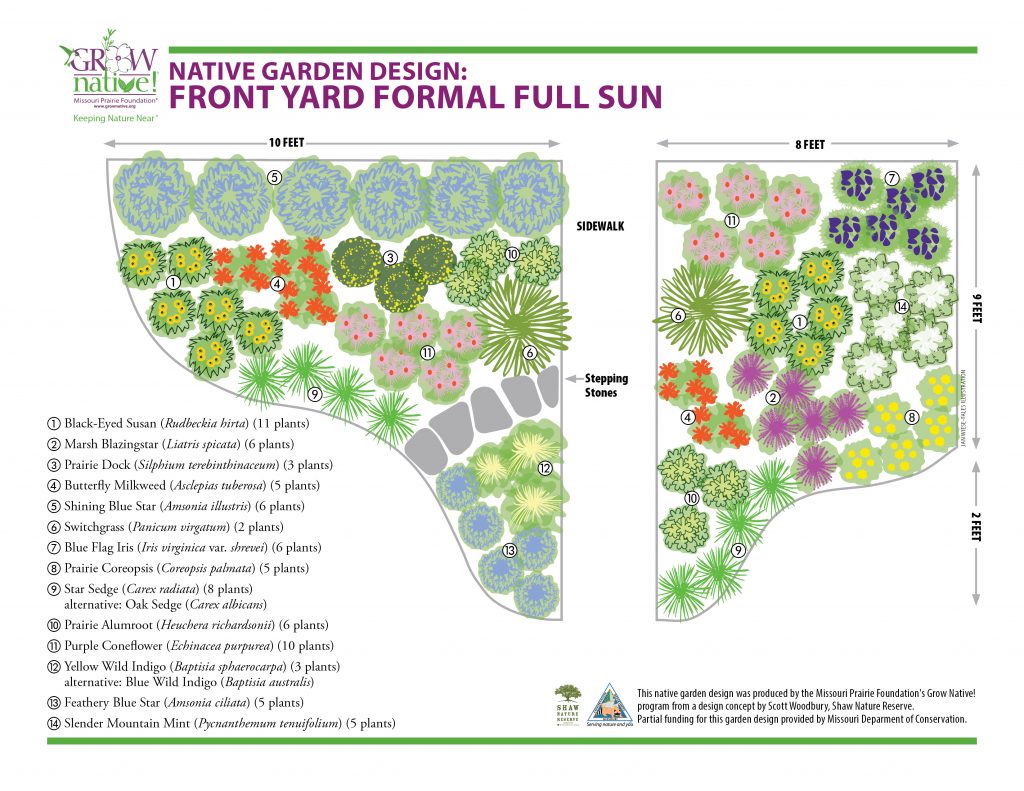
To those who are particularly interested in attracting wildlife, Asher recommends constructing a pocket prairie. Although small in and of themselves, collectively, pocket prairies can have a significant impact the more people create them.
“You’re going to really start to engage with nature in your own backyard in a way that you might not have conceived as possible before,” he says. “The bird life you start to see is amazingly different. You see textures, you see colors.”
In his own pocket prairie, Asher has seen screech owls, black-bellied whistling ducks and different hawk species. “You start to understand you’re living within a system,” he says. “You’re not going to put a pocket prairie in your yard and bison are going to start showing up, but you can have a direct impact on pollinators and birds and your own well-being.”
With so many species and so much to know, it can be easy to get overwhelmed when it comes to planting and growing native prairie plants. But don’t be afraid to start small, Davit says.
“Say you add one or two purple coneflower plants, you will probably see a butterfly coming to those, and that’s really exciting,” she notes. “So just be very proud of yourself for choosing native plants and improving your corner of the world for other species.”

